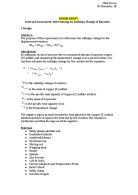IA-Enthalpy Change of Reaction - Zinc and Copper Sulphate.
Chul Ou Lee
IB Chemistry 1B
ROUGH DRAFT
Internal Assessment: Determining An Enthalpy Change of Reaction
I. Design
Objective:
The purpose of this experiment is to determine the enthalpy change for the displacement reaction:
Zn(s) + Cu(aq) -> Cu(s) + Zn2+(aq)
Introduction
By adding an excess of zinc powder to a measured amount of aqueous copper (II) sulfate, and measuring the temperature change over a period of time, you can then calculate the enthalpy change for the reaction by the equation:
is the enthalpy change of reaction
is the mass of copper (II) sulfate
is the specific heat capacity of Copper (II) sulfate solution
is the mass of Zn powder
is the specific heat capacity of Zn
is the temperature change
The negative sign is present because the heat gained by the Copper (II) sulfate solution and Zinc is equal to the heat lost by the reaction. The reaction is exothermic and thus the sign would be negative.
Materials
- Safety glasses and lab coat
- Graduated Cylinder
- Analytical Balance
- Styrofoam cup
- Stirring rod
- Weighing Boat
- Beaker
- Spatula
- Zinc Powder
- 1.00 M CuSO4
- Vernier Labquest and Temperature Probe
- Retort Stand
- Utility clamp
- One hole stopper
- 25mL volumetric pipette
- magnetic stirrer
- stirring chip
Procedures
- Set up Vernier Labquest with a temperature probe. Under “file sensors”-> “data collection”, enter 3s/sample and length=750s
- Place a Styrofoam cup into a 600mL beaker. Measure out 25.0ml of 1.0M CuSO4 using a volumetric pipette into the Styrofoam cup
- Use a utility clamp and a retort clamp to suspend the temperature probe. Lower the temperature probe into the solution.
- Weigh out 6 grams of zinc powder in a weighing boat. There is no need to be accurate because the powder will be in excess.
- Begin data collection, allowing the temperature probe to equilibrate for 90-120 seconds before adding the zinc.
- Add zinc powder to the solution and use a stirring chip on a magnetic stirrer to stir the contents of the cupt until a maximum temperature has been reached and the temperature starts to drop.
- After 750 seconds has finished, discard the solution into the waste containers and save your data.
- Repeat steps 2 to 7 four more times.








